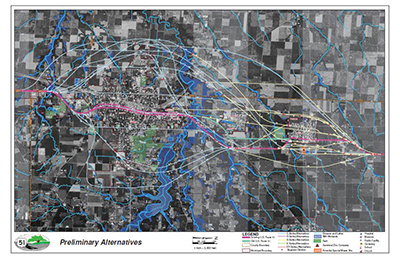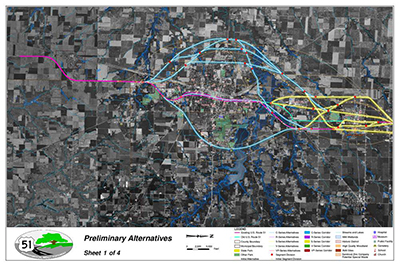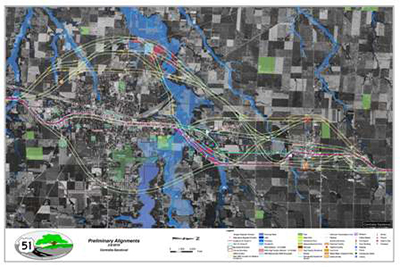CAG #1 – Identified and discussed US 51 transportation problems and community issues.
CAG #2 – Members took a survey to prioritize what characteristics are most important in their community.
CAG #3 – Each group wrote a problem statement for their respective community.
CAG #4 – Brainstorming Alternatives
CAG #5 – Eliminating/Consolidating Alternatives
CAG #6 – Preliminary Corridor Review
CAG #7 – Modified Corridor Review
CAG #8 – Refined Alignment Review
CAG #9 – Remaining Alternatives
Identifying Community Issues – CAG #1
The first step in the Project Process is to identify transportation problems and community issues. IDOT can identify a transportation problem by collecting and analyzing data, but a community’s issues are best heard from the community themselves. The first Citizen’s Advisory Group (CAG) meeting got people thinking and talking about transportation issues in their communities by posing the question, “What problems do you foresee by expanding US 51 to four lanes in your community?” Aerial photographs of the new bypass around Moweaqua were on hand to lend inspiration to exercise. Existing problems with US 51 and future benefits of an improvement were touched on as the groups debated their answers to the question. The ideas shared by the CAG #1 participants were recorded and are available here.
Understanding Community Context – CAG #2
The next step in the Project Process is to try and understand what is important to a community. The characteristics that make a community unique are best identified by its residents. Representing a cross section of their neighbors, Citizen’s Advisory Group members took a survey at CAG #2 to help IDOT better understand the context of their community. Participants taking the survey were given the opportunity to prioritize what characteristics in the survey they believe are most important to their community. Although each community’s context is different, a passion for maintaining and improving the quality of life along the US 51 corridor was evident in each group. The results of Sandoval’s Context Survey can be viewed here. Culture Exhibits and Location Maps and are available below:
| Culture Exhibit | Location Map | |
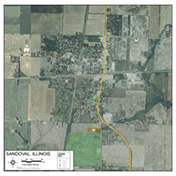 | 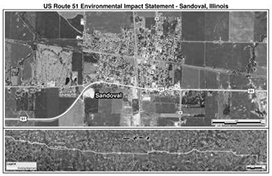 |
Click here for a blank copy of the survey distributed at the meetings.
Defining a Problem Statement – CAG #3
The last step in the Project Process before defining and analyzing alternatives is to define a Problem Statement. The Problem Statement will be referred to throughout the rest of the project. The first measure as to whether an alternative should be studied is, “Does this solve the problem statement?” If yes, the alternative will be considered. IDOT’s problem with US 51 starts with continuity and connectivity. If people, goods and services cannot efficient get to where they need to go, problems also develop with economic development potential and safety. Using IDOT’s problem as a starting point, at CAG #3 each group tailored a statement that was specific to their problems of continuity, connectivity, economic development, and safety.
Brainstorming of Alternatives – CAG #4
Prior to beginning the brainstorming of possible locations for corridors, members of the CAGs were presented with a series of preliminary criteria that engineers, planners, and scientists use when beginning to identify possible locations for a transportation improvement. The information presented as Engineering 101 and Environmental 101 was to be considered when the groups brainstormed ideas. The ideas developed at CAG #4 in addition to those added by the RAG and PSG were complied on one drawing and will be the starting point for the refinement of alternatives at CAG #5.
Original Corridor Alternatives
(Click on map for full size)
Eliminating/Consolidating Alternatives – CAG #5
The fifth set of CAG meetings were held in late February and early March, 2009. The purpose of these meetings was to review the range of preliminary corridors for US 51 developed and eliminate or consolidate corridors that did not meet the project Purpose and Need. The range of alternatives included the ideas brainstormed at CAG #4 in addition to corridor options added by the Regional Advisory Group (at RAG #2) and by the Project Study Group (PSG). Prior to beginning the review of corridors, the project study team reviewed the alternative analysis process and design criteria. The design criteria presented was similar to the information presented at CAG #4 but focused in more detail on specific roadway design elements. The corridors selected by the CAG for further evaluation will be reviewed by the RAG and PSG; additional corridors may be added by the by these groups to ensure that a reasonable range meeting the project Purpose & Need is evaluated. The corridors will undergo a rigorous evaluation by the engineering team that will consider environmental, cultural, community, agricultural, historical and operational impacts. At this time, each of the corridors under consideration is 500’ wide. A narrower roadway alignment will be determined inside the 500’ corridor later in the project.
Click on the links below to view the agenda and handouts from the meeting. To view the range of corridors reviewed at CAG #5, see the exhibits from CAG #4. The corridors still under consideration after CAG #5 were refined and presented for review at CAG #6. See below.
Accident Pattern Countermeasures
Alternative Analysis Procedures
PreliminaryCorridor Review – CAG #6
After brainstorming at CAG #4 and consolidating and eliminating at CAG #5, the committee members were given the opportunity to review the corridors that are being studied further. Some of the corridors that were developed and refined through the previous CAG, RAG, and PSG meetings were modified or combined by the project team if they met the same intent as a similar corridor (or corridors), had the same beginning and end points, and were located in the same general area. Corridors that did not meet the Project’s Purpose & Need (to improve connectivity and continuity) were eliminated from further consideration. From these efforts, a reasonable range of corridors was identified to forward to the FHWA for additional input and can be seen in the exhibits from CAG #6 (link below). The next step in the process was to develop preliminary roadway alignments within the corridors still under consideration and present them at Public Information Meeting #3.
Preferred Corridor Alternatives
(Click on map for full size)
Modified Corridor Review – CAG #7
In December 2009 the project team received additional information from the Illinois Natural History Survey (INHS) which identified high-quality wetland areas along the bypass corridors around Centralia/Central City, Sandoval, Patoka, Vernon, and Vandalia. In light of this new data, the project team modified some of the preliminary corridors to avoid impacting these high quality wetland areas. Exhibits of the modified corridors were presented during CAG #7 to solicit input from committee members.
As a result of CAG #7, the project team developed alignments to fit within the modified corridors. These alignments were presented this spring at Public Information Meeting #4. Comments received from PIM #4 were taken into consideration as the project team asked for concurrence to move forward with recommended corridors from the Federal Highway Administration (FHWA) in June 2010. An exhibit depicting the revised corridors can be seen below.
Please note that at the June meeting, the resource agencies approved all recommended alternatives, with the exception of Centralia-Sandoval Alignment D. Centralia-Sandoval Alignment D is an eastern bypass that crosses Raccoon Lake. Alignment D exhibited the greatest number of impacts to floodplains, wetlands, high quality wetlands , homes, and commercial and public facility buildings in comparison to the remaining alignments on the west side of Centralia. Therefore, Alignment D was eliminated from further consideration.
Modified Corridor Alternatives
(Click on map for full size)
Refined Alignment Review – CAG #8
The draft refined alignments, including proposed access locations, were displayed on aerial maps. The CAG members were asked to review the maps and provide input on the alignments and proposed access. The majority of the Sandoval CAG members preferred Alignment DL over Alignment DJ. Alignment DL travels east of Sandoval, and Alignment DJ travels west of Sandoval. The project team is in the process of further refining the alignments.
The exhibits presented at CAG#8 were identical to the exhibits presented at PIM#5. To view the PIM#5 exhibits, please visit the documents page.
Remaining Alternatives – CAG #9
The two remaining alternatives near Sandoval were displayed on aerial maps. The maps displayed environmental and community impacts. A summary table of impacts resulting from each alternative was presented. A handout was distributed to explain how the resource impacts were counted. A comment form was distributed to each member to provide comments on the remaining alternatives.
The handouts, exhibits, and comment form distributed during the meeting are available in the documents section.
